Business Environment, Structures, Objectives, and Organizations
VerifiedAdded on 2021/07/01
|16
|4533
|78
Report
AI Summary
This report examines the business environment, including the definition of business and organizations, and the climate or set of conditions in which business operations are conducted. It explores different types of organizations, such as public, private, and voluntary sectors, and their respective purposes. The report then delves into legal business structures, including sole proprietorships, partnerships (including limited liability partnerships), and corporations, outlining their purposes and characteristics. Different classifications of companies, such as private and public companies, are also discussed. The report provides an analysis of the size and scope of various organizations, using Unilever and GSK as case studies. It covers their overall performance, locations of operations, market share, competitors, vision, mission, objectives, key stakeholders, and organizational structures, linking these elements to their business objectives and the products and services they offer. The report further explores different organizational structures, including hierarchical, functional, horizontal, and divisional structures, and their implications for business operations.
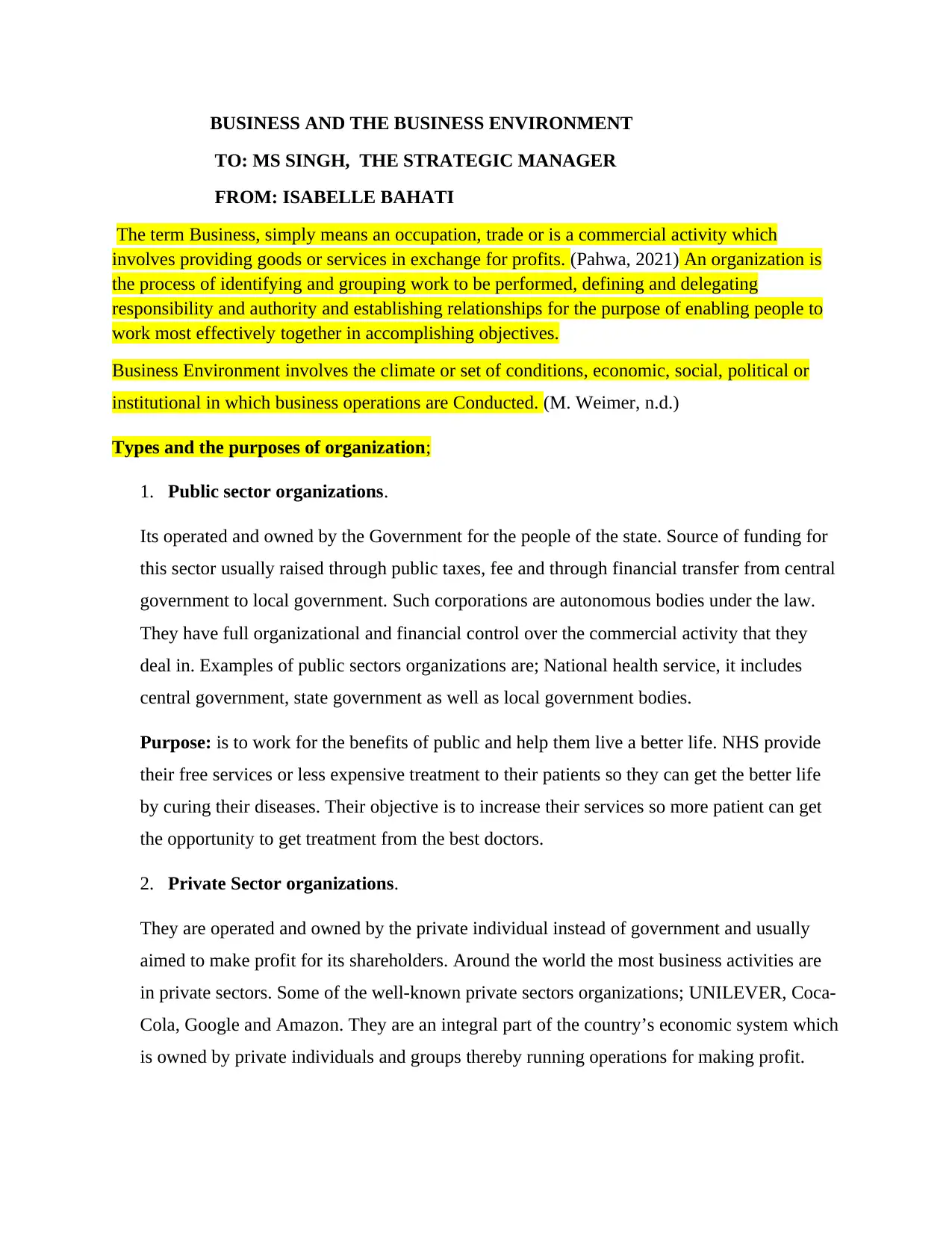
BUSINESS AND THE BUSINESS ENVIRONMENT
TO: MS SINGH, THE STRATEGIC MANAGER
FROM: ISABELLE BAHATI
The term Business, simply means an occupation, trade or is a commercial activity which
involves providing goods or services in exchange for profits. (Pahwa, 2021) An organization is
the process of identifying and grouping work to be performed, defining and delegating
responsibility and authority and establishing relationships for the purpose of enabling people to
work most effectively together in accomplishing objectives.
Business Environment involves the climate or set of conditions, economic, social, political or
institutional in which business operations are Conducted. (M. Weimer, n.d.)
Types and the purposes of organization;
1. Public sector organizations.
Its operated and owned by the Government for the people of the state. Source of funding for
this sector usually raised through public taxes, fee and through financial transfer from central
government to local government. Such corporations are autonomous bodies under the law.
They have full organizational and financial control over the commercial activity that they
deal in. Examples of public sectors organizations are; National health service, it includes
central government, state government as well as local government bodies.
Purpose: is to work for the benefits of public and help them live a better life. NHS provide
their free services or less expensive treatment to their patients so they can get the better life
by curing their diseases. Their objective is to increase their services so more patient can get
the opportunity to get treatment from the best doctors.
2. Private Sector organizations.
They are operated and owned by the private individual instead of government and usually
aimed to make profit for its shareholders. Around the world the most business activities are
in private sectors. Some of the well-known private sectors organizations; UNILEVER, Coca-
Cola, Google and Amazon. They are an integral part of the country’s economic system which
is owned by private individuals and groups thereby running operations for making profit.
TO: MS SINGH, THE STRATEGIC MANAGER
FROM: ISABELLE BAHATI
The term Business, simply means an occupation, trade or is a commercial activity which
involves providing goods or services in exchange for profits. (Pahwa, 2021) An organization is
the process of identifying and grouping work to be performed, defining and delegating
responsibility and authority and establishing relationships for the purpose of enabling people to
work most effectively together in accomplishing objectives.
Business Environment involves the climate or set of conditions, economic, social, political or
institutional in which business operations are Conducted. (M. Weimer, n.d.)
Types and the purposes of organization;
1. Public sector organizations.
Its operated and owned by the Government for the people of the state. Source of funding for
this sector usually raised through public taxes, fee and through financial transfer from central
government to local government. Such corporations are autonomous bodies under the law.
They have full organizational and financial control over the commercial activity that they
deal in. Examples of public sectors organizations are; National health service, it includes
central government, state government as well as local government bodies.
Purpose: is to work for the benefits of public and help them live a better life. NHS provide
their free services or less expensive treatment to their patients so they can get the better life
by curing their diseases. Their objective is to increase their services so more patient can get
the opportunity to get treatment from the best doctors.
2. Private Sector organizations.
They are operated and owned by the private individual instead of government and usually
aimed to make profit for its shareholders. Around the world the most business activities are
in private sectors. Some of the well-known private sectors organizations; UNILEVER, Coca-
Cola, Google and Amazon. They are an integral part of the country’s economic system which
is owned by private individuals and groups thereby running operations for making profit.
Paraphrase This Document
Need a fresh take? Get an instant paraphrase of this document with our AI Paraphraser
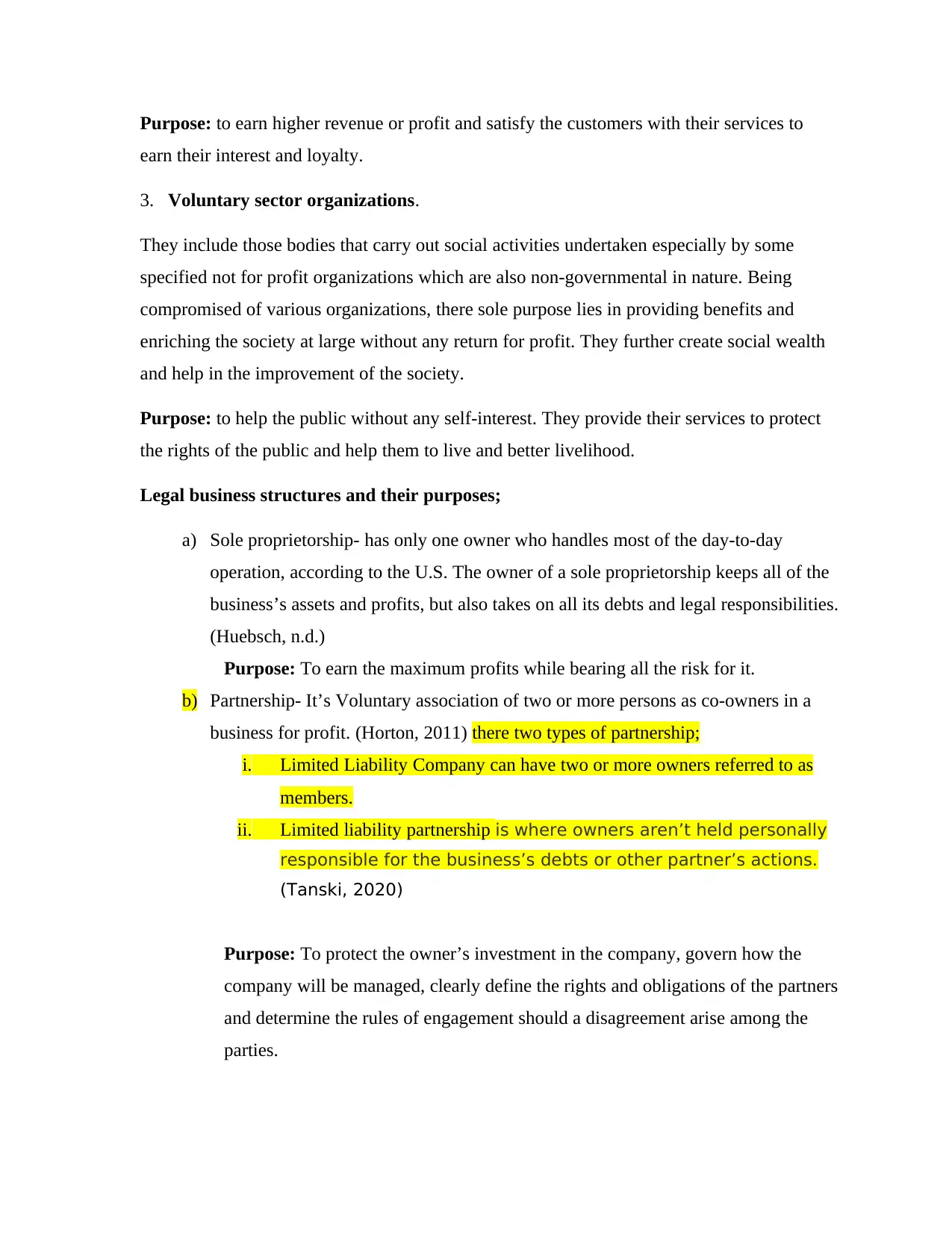
Purpose: to earn higher revenue or profit and satisfy the customers with their services to
earn their interest and loyalty.
3. Voluntary sector organizations.
They include those bodies that carry out social activities undertaken especially by some
specified not for profit organizations which are also non-governmental in nature. Being
compromised of various organizations, there sole purpose lies in providing benefits and
enriching the society at large without any return for profit. They further create social wealth
and help in the improvement of the society.
Purpose: to help the public without any self-interest. They provide their services to protect
the rights of the public and help them to live and better livelihood.
Legal business structures and their purposes;
a) Sole proprietorship- has only one owner who handles most of the day-to-day
operation, according to the U.S. The owner of a sole proprietorship keeps all of the
business’s assets and profits, but also takes on all its debts and legal responsibilities.
(Huebsch, n.d.)
Purpose: To earn the maximum profits while bearing all the risk for it.
b) Partnership- It’s Voluntary association of two or more persons as co-owners in a
business for profit. (Horton, 2011) there two types of partnership;
i. Limited Liability Company can have two or more owners referred to as
members.
ii. Limited liability partnership is where owners aren’t held personally
responsible for the business’s debts or other partner’s actions.
(Tanski, 2020)
Purpose: To protect the owner’s investment in the company, govern how the
company will be managed, clearly define the rights and obligations of the partners
and determine the rules of engagement should a disagreement arise among the
parties.
earn their interest and loyalty.
3. Voluntary sector organizations.
They include those bodies that carry out social activities undertaken especially by some
specified not for profit organizations which are also non-governmental in nature. Being
compromised of various organizations, there sole purpose lies in providing benefits and
enriching the society at large without any return for profit. They further create social wealth
and help in the improvement of the society.
Purpose: to help the public without any self-interest. They provide their services to protect
the rights of the public and help them to live and better livelihood.
Legal business structures and their purposes;
a) Sole proprietorship- has only one owner who handles most of the day-to-day
operation, according to the U.S. The owner of a sole proprietorship keeps all of the
business’s assets and profits, but also takes on all its debts and legal responsibilities.
(Huebsch, n.d.)
Purpose: To earn the maximum profits while bearing all the risk for it.
b) Partnership- It’s Voluntary association of two or more persons as co-owners in a
business for profit. (Horton, 2011) there two types of partnership;
i. Limited Liability Company can have two or more owners referred to as
members.
ii. Limited liability partnership is where owners aren’t held personally
responsible for the business’s debts or other partner’s actions.
(Tanski, 2020)
Purpose: To protect the owner’s investment in the company, govern how the
company will be managed, clearly define the rights and obligations of the partners
and determine the rules of engagement should a disagreement arise among the
parties.
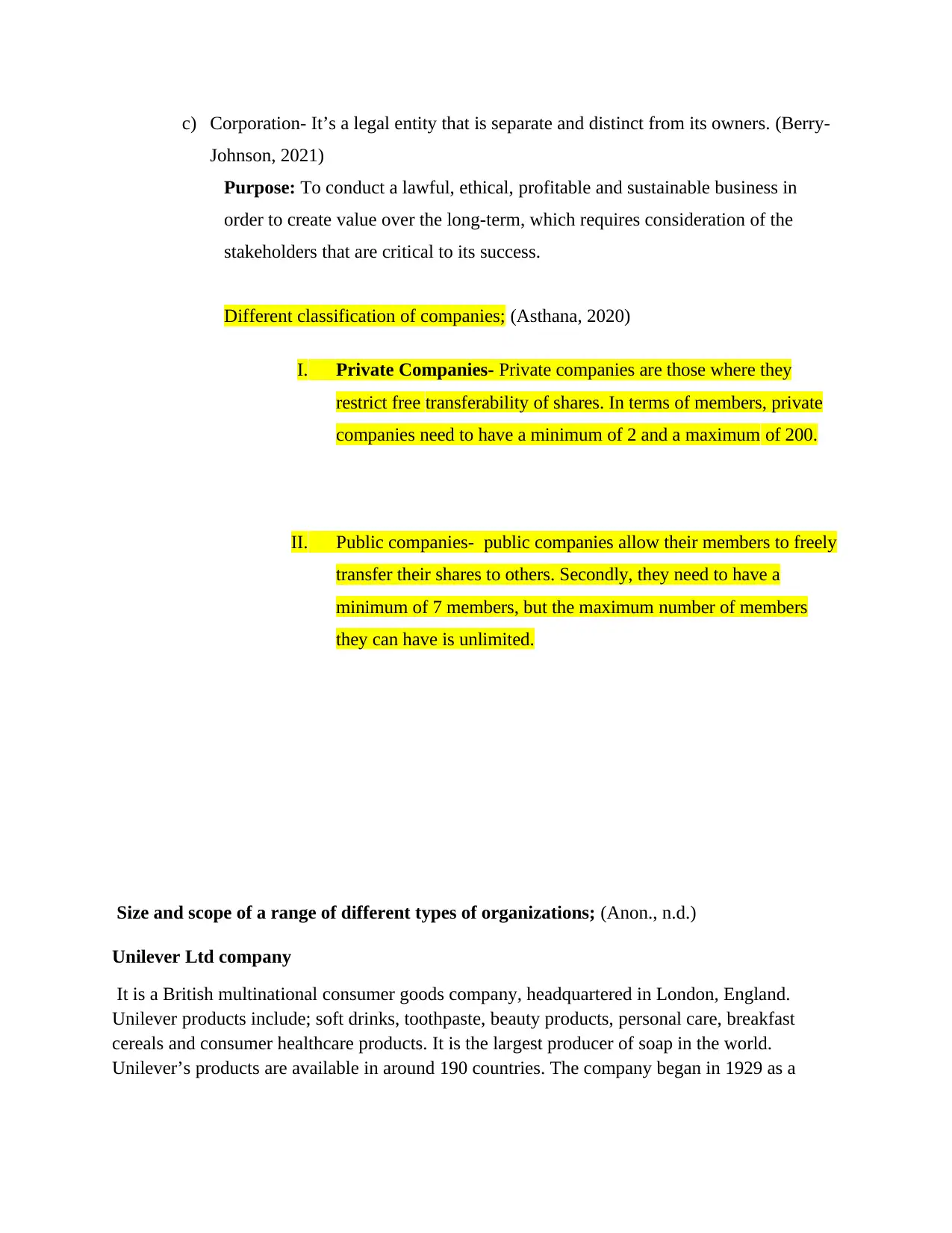
c) Corporation- It’s a legal entity that is separate and distinct from its owners. (Berry-
Johnson, 2021)
Purpose: To conduct a lawful, ethical, profitable and sustainable business in
order to create value over the long-term, which requires consideration of the
stakeholders that are critical to its success.
Different classification of companies; (Asthana, 2020)
I. Private Companies- Private companies are those where they
restrict free transferability of shares. In terms of members, private
companies need to have a minimum of 2 and a maximum of 200.
II. Public companies- public companies allow their members to freely
transfer their shares to others. Secondly, they need to have a
minimum of 7 members, but the maximum number of members
they can have is unlimited.
Size and scope of a range of different types of organizations; (Anon., n.d.)
Unilever Ltd company
It is a British multinational consumer goods company, headquartered in London, England.
Unilever products include; soft drinks, toothpaste, beauty products, personal care, breakfast
cereals and consumer healthcare products. It is the largest producer of soap in the world.
Unilever’s products are available in around 190 countries. The company began in 1929 as a
Johnson, 2021)
Purpose: To conduct a lawful, ethical, profitable and sustainable business in
order to create value over the long-term, which requires consideration of the
stakeholders that are critical to its success.
Different classification of companies; (Asthana, 2020)
I. Private Companies- Private companies are those where they
restrict free transferability of shares. In terms of members, private
companies need to have a minimum of 2 and a maximum of 200.
II. Public companies- public companies allow their members to freely
transfer their shares to others. Secondly, they need to have a
minimum of 7 members, but the maximum number of members
they can have is unlimited.
Size and scope of a range of different types of organizations; (Anon., n.d.)
Unilever Ltd company
It is a British multinational consumer goods company, headquartered in London, England.
Unilever products include; soft drinks, toothpaste, beauty products, personal care, breakfast
cereals and consumer healthcare products. It is the largest producer of soap in the world.
Unilever’s products are available in around 190 countries. The company began in 1929 as a
⊘ This is a preview!⊘
Do you want full access?
Subscribe today to unlock all pages.

Trusted by 1+ million students worldwide
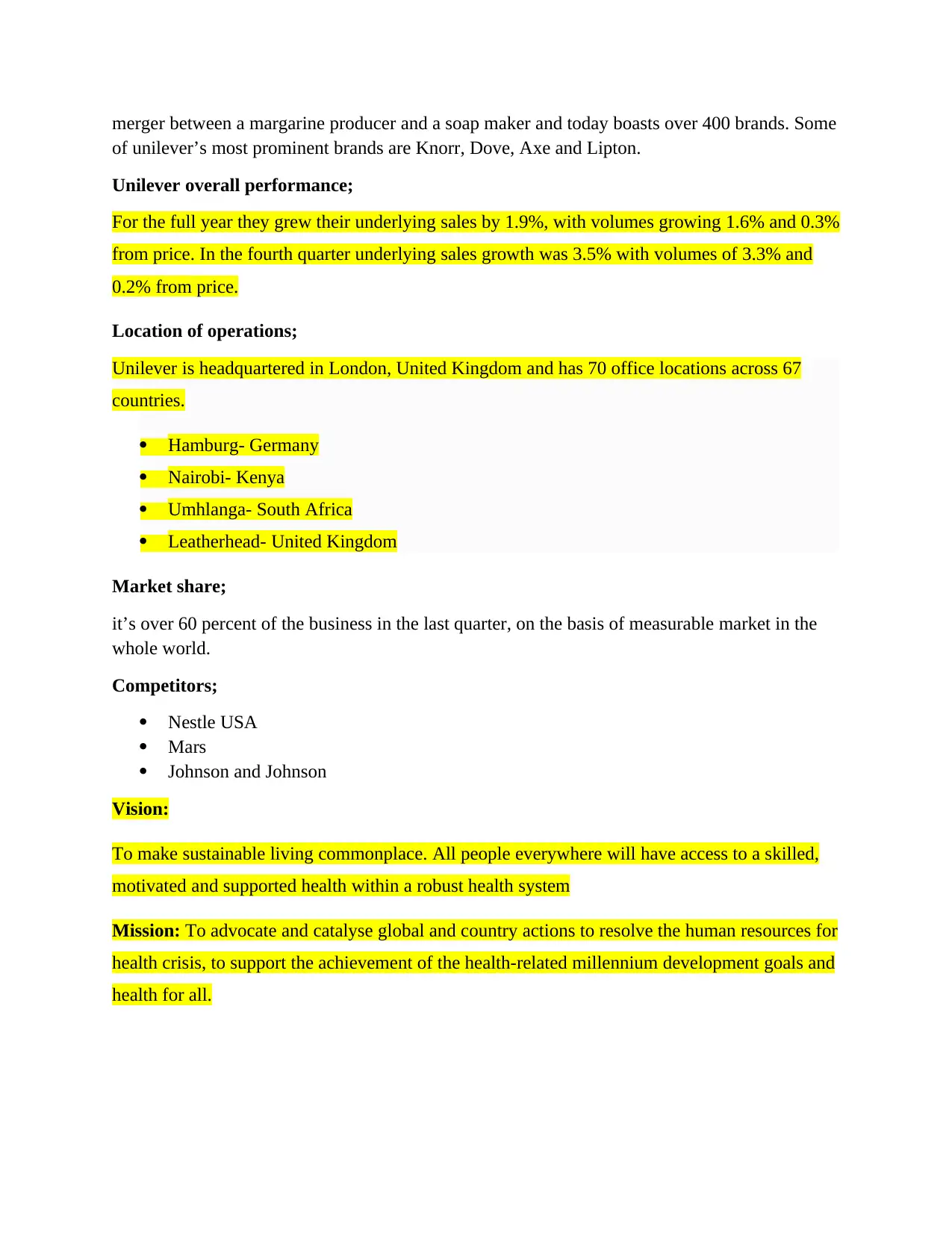
merger between a margarine producer and a soap maker and today boasts over 400 brands. Some
of unilever’s most prominent brands are Knorr, Dove, Axe and Lipton.
Unilever overall performance;
For the full year they grew their underlying sales by 1.9%, with volumes growing 1.6% and 0.3%
from price. In the fourth quarter underlying sales growth was 3.5% with volumes of 3.3% and
0.2% from price.
Location of operations;
Unilever is headquartered in London, United Kingdom and has 70 office locations across 67
countries.
Hamburg- Germany
Nairobi- Kenya
Umhlanga- South Africa
Leatherhead- United Kingdom
Market share;
it’s over 60 percent of the business in the last quarter, on the basis of measurable market in the
whole world.
Competitors;
Nestle USA
Mars
Johnson and Johnson
Vision:
To make sustainable living commonplace. All people everywhere will have access to a skilled,
motivated and supported health within a robust health system
Mission: To advocate and catalyse global and country actions to resolve the human resources for
health crisis, to support the achievement of the health-related millennium development goals and
health for all.
of unilever’s most prominent brands are Knorr, Dove, Axe and Lipton.
Unilever overall performance;
For the full year they grew their underlying sales by 1.9%, with volumes growing 1.6% and 0.3%
from price. In the fourth quarter underlying sales growth was 3.5% with volumes of 3.3% and
0.2% from price.
Location of operations;
Unilever is headquartered in London, United Kingdom and has 70 office locations across 67
countries.
Hamburg- Germany
Nairobi- Kenya
Umhlanga- South Africa
Leatherhead- United Kingdom
Market share;
it’s over 60 percent of the business in the last quarter, on the basis of measurable market in the
whole world.
Competitors;
Nestle USA
Mars
Johnson and Johnson
Vision:
To make sustainable living commonplace. All people everywhere will have access to a skilled,
motivated and supported health within a robust health system
Mission: To advocate and catalyse global and country actions to resolve the human resources for
health crisis, to support the achievement of the health-related millennium development goals and
health for all.
Paraphrase This Document
Need a fresh take? Get an instant paraphrase of this document with our AI Paraphraser
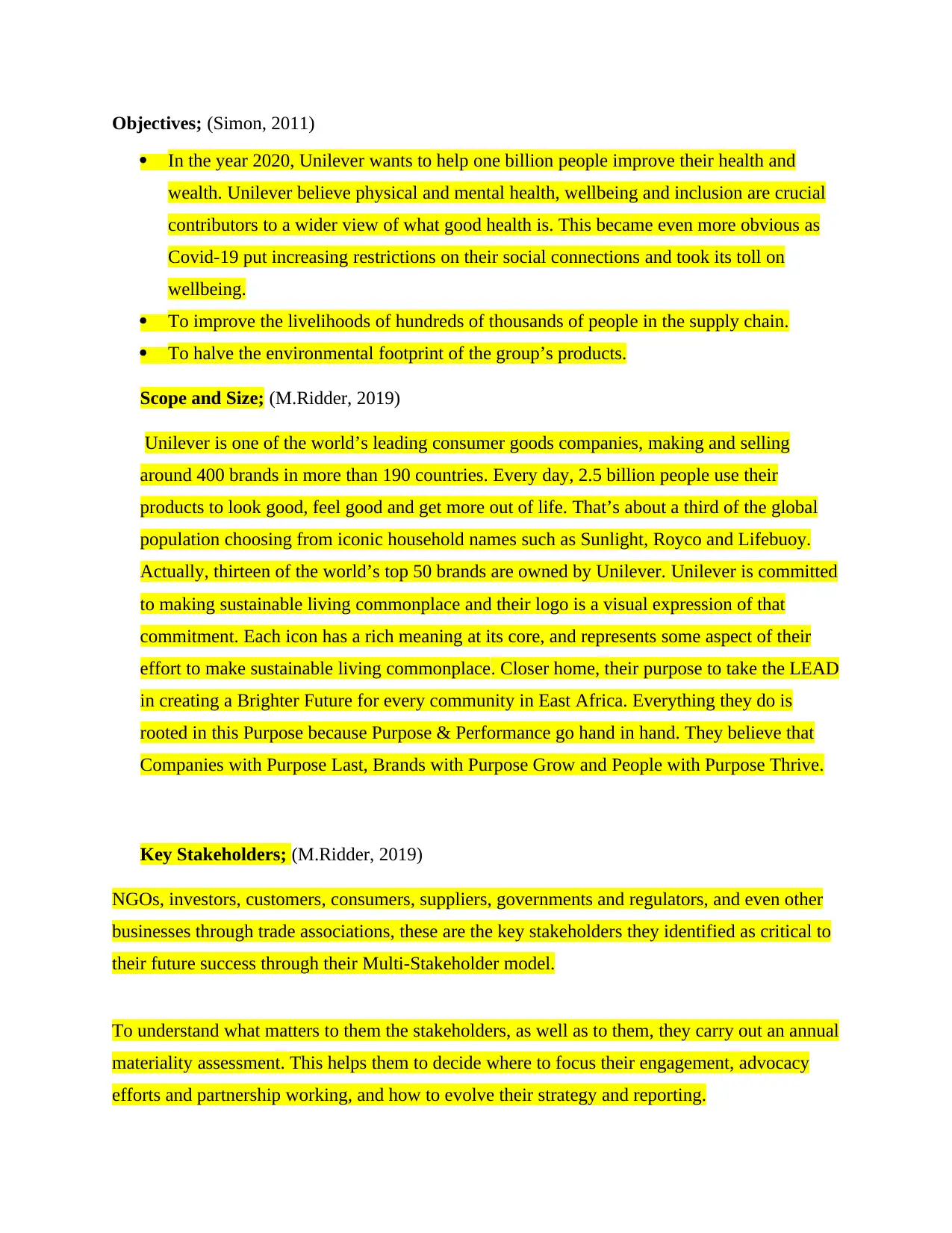
Objectives; (Simon, 2011)
In the year 2020, Unilever wants to help one billion people improve their health and
wealth. Unilever believe physical and mental health, wellbeing and inclusion are crucial
contributors to a wider view of what good health is. This became even more obvious as
Covid-19 put increasing restrictions on their social connections and took its toll on
wellbeing.
To improve the livelihoods of hundreds of thousands of people in the supply chain.
To halve the environmental footprint of the group’s products.
Scope and Size; (M.Ridder, 2019)
Unilever is one of the world’s leading consumer goods companies, making and selling
around 400 brands in more than 190 countries. Every day, 2.5 billion people use their
products to look good, feel good and get more out of life. That’s about a third of the global
population choosing from iconic household names such as Sunlight, Royco and Lifebuoy.
Actually, thirteen of the world’s top 50 brands are owned by Unilever. Unilever is committed
to making sustainable living commonplace and their logo is a visual expression of that
commitment. Each icon has a rich meaning at its core, and represents some aspect of their
effort to make sustainable living commonplace. Closer home, their purpose to take the LEAD
in creating a Brighter Future for every community in East Africa. Everything they do is
rooted in this Purpose because Purpose & Performance go hand in hand. They believe that
Companies with Purpose Last, Brands with Purpose Grow and People with Purpose Thrive.
Key Stakeholders; (M.Ridder, 2019)
NGOs, investors, customers, consumers, suppliers, governments and regulators, and even other
businesses through trade associations, these are the key stakeholders they identified as critical to
their future success through their Multi-Stakeholder model.
To understand what matters to them the stakeholders, as well as to them, they carry out an annual
materiality assessment. This helps them to decide where to focus their engagement, advocacy
efforts and partnership working, and how to evolve their strategy and reporting.
In the year 2020, Unilever wants to help one billion people improve their health and
wealth. Unilever believe physical and mental health, wellbeing and inclusion are crucial
contributors to a wider view of what good health is. This became even more obvious as
Covid-19 put increasing restrictions on their social connections and took its toll on
wellbeing.
To improve the livelihoods of hundreds of thousands of people in the supply chain.
To halve the environmental footprint of the group’s products.
Scope and Size; (M.Ridder, 2019)
Unilever is one of the world’s leading consumer goods companies, making and selling
around 400 brands in more than 190 countries. Every day, 2.5 billion people use their
products to look good, feel good and get more out of life. That’s about a third of the global
population choosing from iconic household names such as Sunlight, Royco and Lifebuoy.
Actually, thirteen of the world’s top 50 brands are owned by Unilever. Unilever is committed
to making sustainable living commonplace and their logo is a visual expression of that
commitment. Each icon has a rich meaning at its core, and represents some aspect of their
effort to make sustainable living commonplace. Closer home, their purpose to take the LEAD
in creating a Brighter Future for every community in East Africa. Everything they do is
rooted in this Purpose because Purpose & Performance go hand in hand. They believe that
Companies with Purpose Last, Brands with Purpose Grow and People with Purpose Thrive.
Key Stakeholders; (M.Ridder, 2019)
NGOs, investors, customers, consumers, suppliers, governments and regulators, and even other
businesses through trade associations, these are the key stakeholders they identified as critical to
their future success through their Multi-Stakeholder model.
To understand what matters to them the stakeholders, as well as to them, they carry out an annual
materiality assessment. This helps them to decide where to focus their engagement, advocacy
efforts and partnership working, and how to evolve their strategy and reporting.
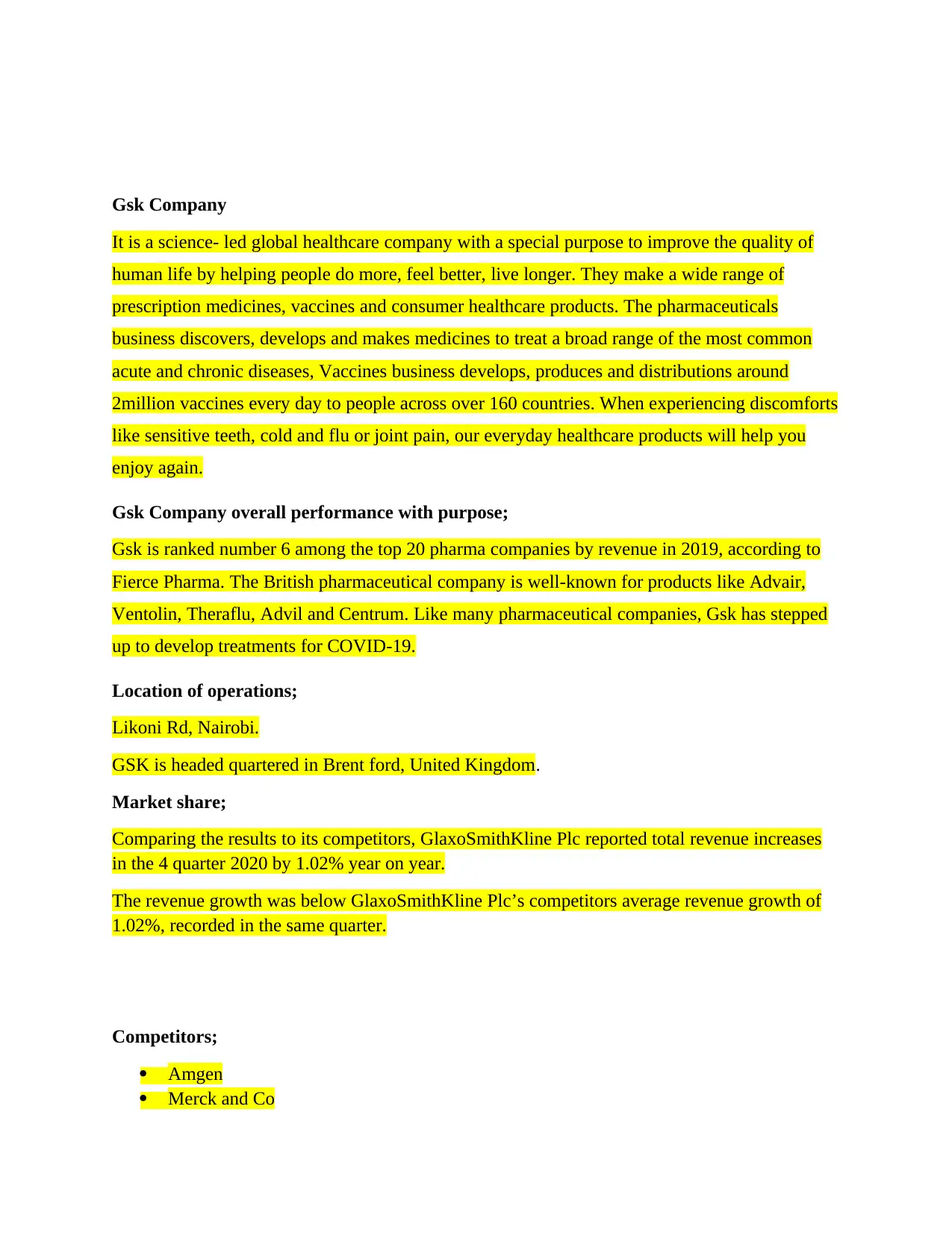
Gsk Company
It is a science- led global healthcare company with a special purpose to improve the quality of
human life by helping people do more, feel better, live longer. They make a wide range of
prescription medicines, vaccines and consumer healthcare products. The pharmaceuticals
business discovers, develops and makes medicines to treat a broad range of the most common
acute and chronic diseases, Vaccines business develops, produces and distributions around
2million vaccines every day to people across over 160 countries. When experiencing discomforts
like sensitive teeth, cold and flu or joint pain, our everyday healthcare products will help you
enjoy again.
Gsk Company overall performance with purpose;
Gsk is ranked number 6 among the top 20 pharma companies by revenue in 2019, according to
Fierce Pharma. The British pharmaceutical company is well-known for products like Advair,
Ventolin, Theraflu, Advil and Centrum. Like many pharmaceutical companies, Gsk has stepped
up to develop treatments for COVID-19.
Location of operations;
Likoni Rd, Nairobi.
GSK is headed quartered in Brent ford, United Kingdom.
Market share;
Comparing the results to its competitors, GlaxoSmithKline Plc reported total revenue increases
in the 4 quarter 2020 by 1.02% year on year.
The revenue growth was below GlaxoSmithKline Plc’s competitors average revenue growth of
1.02%, recorded in the same quarter.
Competitors;
Amgen
Merck and Co
It is a science- led global healthcare company with a special purpose to improve the quality of
human life by helping people do more, feel better, live longer. They make a wide range of
prescription medicines, vaccines and consumer healthcare products. The pharmaceuticals
business discovers, develops and makes medicines to treat a broad range of the most common
acute and chronic diseases, Vaccines business develops, produces and distributions around
2million vaccines every day to people across over 160 countries. When experiencing discomforts
like sensitive teeth, cold and flu or joint pain, our everyday healthcare products will help you
enjoy again.
Gsk Company overall performance with purpose;
Gsk is ranked number 6 among the top 20 pharma companies by revenue in 2019, according to
Fierce Pharma. The British pharmaceutical company is well-known for products like Advair,
Ventolin, Theraflu, Advil and Centrum. Like many pharmaceutical companies, Gsk has stepped
up to develop treatments for COVID-19.
Location of operations;
Likoni Rd, Nairobi.
GSK is headed quartered in Brent ford, United Kingdom.
Market share;
Comparing the results to its competitors, GlaxoSmithKline Plc reported total revenue increases
in the 4 quarter 2020 by 1.02% year on year.
The revenue growth was below GlaxoSmithKline Plc’s competitors average revenue growth of
1.02%, recorded in the same quarter.
Competitors;
Amgen
Merck and Co
⊘ This is a preview!⊘
Do you want full access?
Subscribe today to unlock all pages.

Trusted by 1+ million students worldwide
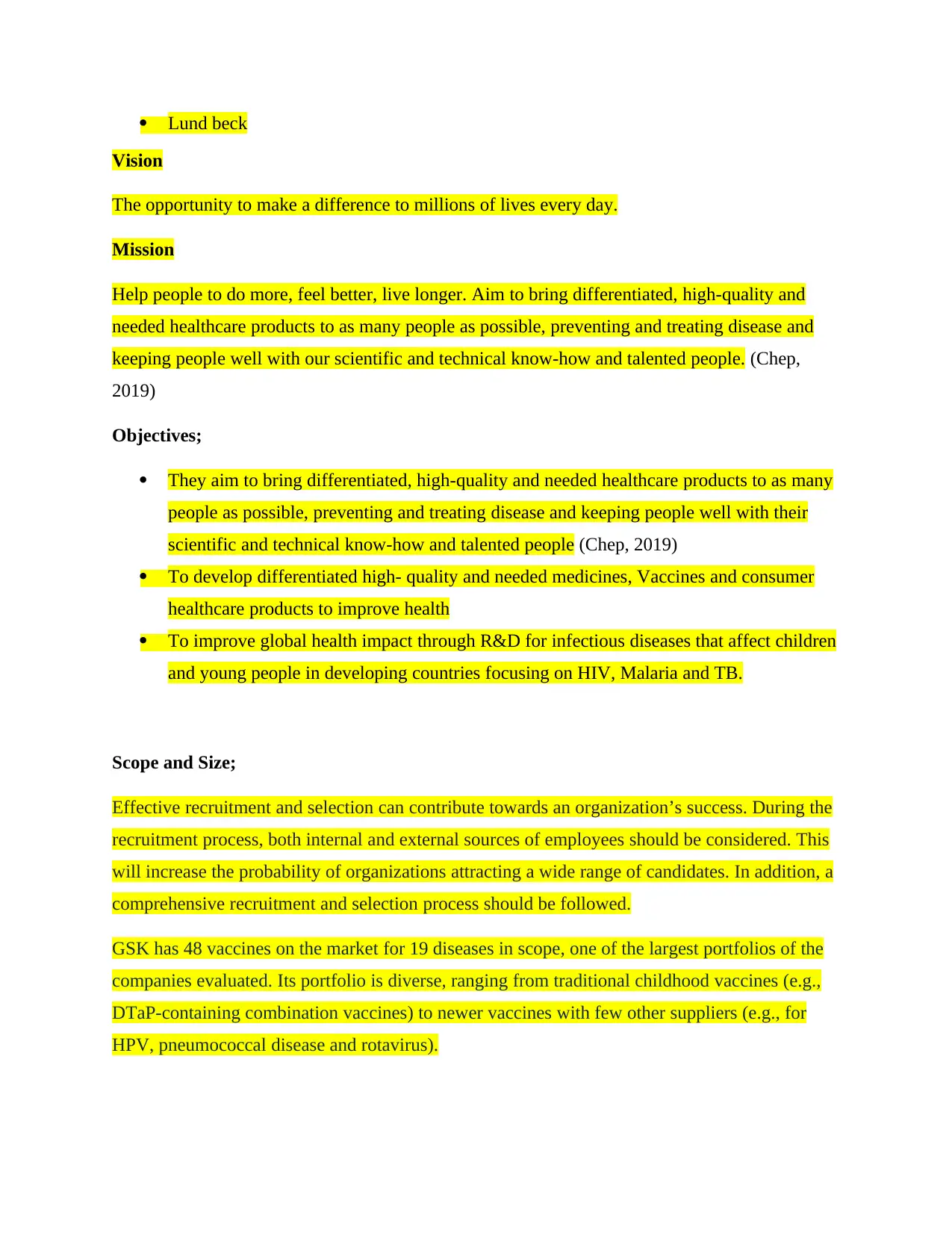
Lund beck
Vision
The opportunity to make a difference to millions of lives every day.
Mission
Help people to do more, feel better, live longer. Aim to bring differentiated, high-quality and
needed healthcare products to as many people as possible, preventing and treating disease and
keeping people well with our scientific and technical know-how and talented people. (Chep,
2019)
Objectives;
They aim to bring differentiated, high-quality and needed healthcare products to as many
people as possible, preventing and treating disease and keeping people well with their
scientific and technical know-how and talented people (Chep, 2019)
To develop differentiated high- quality and needed medicines, Vaccines and consumer
healthcare products to improve health
To improve global health impact through R&D for infectious diseases that affect children
and young people in developing countries focusing on HIV, Malaria and TB.
Scope and Size;
Effective recruitment and selection can contribute towards an organization’s success. During the
recruitment process, both internal and external sources of employees should be considered. This
will increase the probability of organizations attracting a wide range of candidates. In addition, a
comprehensive recruitment and selection process should be followed.
GSK has 48 vaccines on the market for 19 diseases in scope, one of the largest portfolios of the
companies evaluated. Its portfolio is diverse, ranging from traditional childhood vaccines (e.g.,
DTaP-containing combination vaccines) to newer vaccines with few other suppliers (e.g., for
HPV, pneumococcal disease and rotavirus).
Vision
The opportunity to make a difference to millions of lives every day.
Mission
Help people to do more, feel better, live longer. Aim to bring differentiated, high-quality and
needed healthcare products to as many people as possible, preventing and treating disease and
keeping people well with our scientific and technical know-how and talented people. (Chep,
2019)
Objectives;
They aim to bring differentiated, high-quality and needed healthcare products to as many
people as possible, preventing and treating disease and keeping people well with their
scientific and technical know-how and talented people (Chep, 2019)
To develop differentiated high- quality and needed medicines, Vaccines and consumer
healthcare products to improve health
To improve global health impact through R&D for infectious diseases that affect children
and young people in developing countries focusing on HIV, Malaria and TB.
Scope and Size;
Effective recruitment and selection can contribute towards an organization’s success. During the
recruitment process, both internal and external sources of employees should be considered. This
will increase the probability of organizations attracting a wide range of candidates. In addition, a
comprehensive recruitment and selection process should be followed.
GSK has 48 vaccines on the market for 19 diseases in scope, one of the largest portfolios of the
companies evaluated. Its portfolio is diverse, ranging from traditional childhood vaccines (e.g.,
DTaP-containing combination vaccines) to newer vaccines with few other suppliers (e.g., for
HPV, pneumococcal disease and rotavirus).
Paraphrase This Document
Need a fresh take? Get an instant paraphrase of this document with our AI Paraphraser
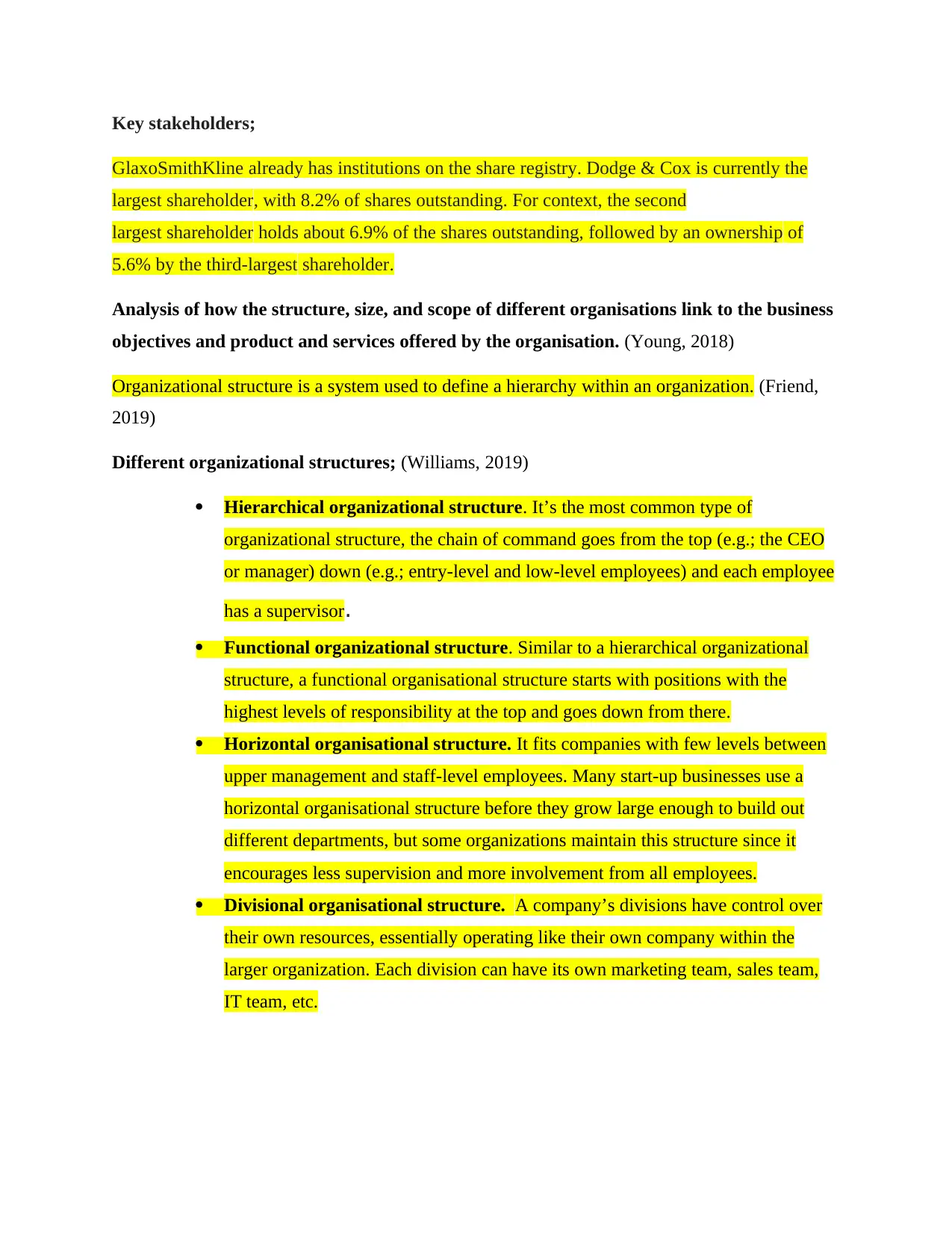
Key stakeholders;
GlaxoSmithKline already has institutions on the share registry. Dodge & Cox is currently the
largest shareholder, with 8.2% of shares outstanding. For context, the second
largest shareholder holds about 6.9% of the shares outstanding, followed by an ownership of
5.6% by the third-largest shareholder.
Analysis of how the structure, size, and scope of different organisations link to the business
objectives and product and services offered by the organisation. (Young, 2018)
Organizational structure is a system used to define a hierarchy within an organization. (Friend,
2019)
Different organizational structures; (Williams, 2019)
Hierarchical organizational structure. It’s the most common type of
organizational structure, the chain of command goes from the top (e.g.; the CEO
or manager) down (e.g.; entry-level and low-level employees) and each employee
has a supervisor.
Functional organizational structure. Similar to a hierarchical organizational
structure, a functional organisational structure starts with positions with the
highest levels of responsibility at the top and goes down from there.
Horizontal organisational structure. It fits companies with few levels between
upper management and staff-level employees. Many start-up businesses use a
horizontal organisational structure before they grow large enough to build out
different departments, but some organizations maintain this structure since it
encourages less supervision and more involvement from all employees.
Divisional organisational structure. A company’s divisions have control over
their own resources, essentially operating like their own company within the
larger organization. Each division can have its own marketing team, sales team,
IT team, etc.
GlaxoSmithKline already has institutions on the share registry. Dodge & Cox is currently the
largest shareholder, with 8.2% of shares outstanding. For context, the second
largest shareholder holds about 6.9% of the shares outstanding, followed by an ownership of
5.6% by the third-largest shareholder.
Analysis of how the structure, size, and scope of different organisations link to the business
objectives and product and services offered by the organisation. (Young, 2018)
Organizational structure is a system used to define a hierarchy within an organization. (Friend,
2019)
Different organizational structures; (Williams, 2019)
Hierarchical organizational structure. It’s the most common type of
organizational structure, the chain of command goes from the top (e.g.; the CEO
or manager) down (e.g.; entry-level and low-level employees) and each employee
has a supervisor.
Functional organizational structure. Similar to a hierarchical organizational
structure, a functional organisational structure starts with positions with the
highest levels of responsibility at the top and goes down from there.
Horizontal organisational structure. It fits companies with few levels between
upper management and staff-level employees. Many start-up businesses use a
horizontal organisational structure before they grow large enough to build out
different departments, but some organizations maintain this structure since it
encourages less supervision and more involvement from all employees.
Divisional organisational structure. A company’s divisions have control over
their own resources, essentially operating like their own company within the
larger organization. Each division can have its own marketing team, sales team,
IT team, etc.
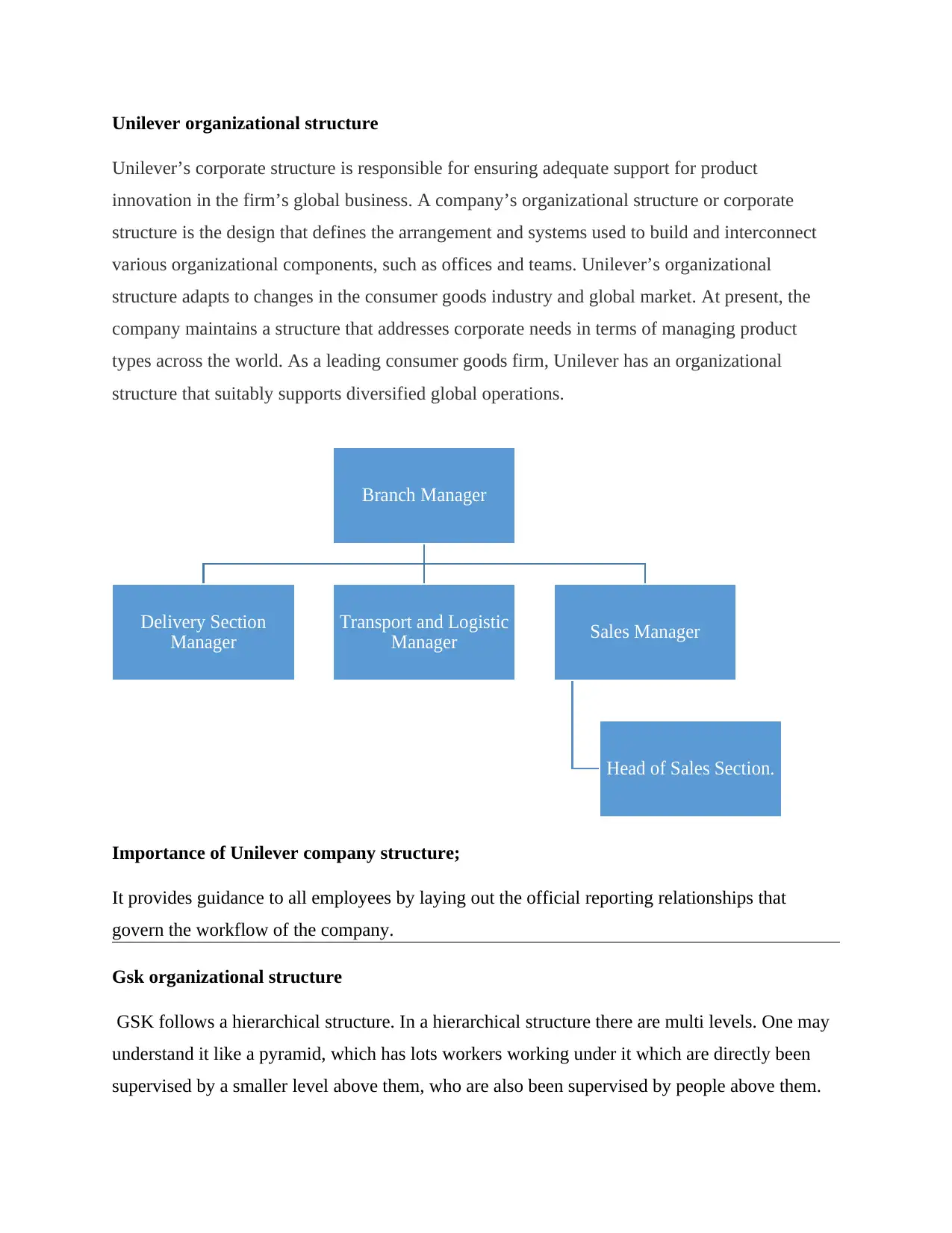
Unilever organizational structure
Unilever’s corporate structure is responsible for ensuring adequate support for product
innovation in the firm’s global business. A company’s organizational structure or corporate
structure is the design that defines the arrangement and systems used to build and interconnect
various organizational components, such as offices and teams. Unilever’s organizational
structure adapts to changes in the consumer goods industry and global market. At present, the
company maintains a structure that addresses corporate needs in terms of managing product
types across the world. As a leading consumer goods firm, Unilever has an organizational
structure that suitably supports diversified global operations.
Importance of Unilever company structure;
It provides guidance to all employees by laying out the official reporting relationships that
govern the workflow of the company.
Gsk organizational structure
GSK follows a hierarchical structure. In a hierarchical structure there are multi levels. One may
understand it like a pyramid, which has lots workers working under it which are directly been
supervised by a smaller level above them, who are also been supervised by people above them.
Branch Manager
Delivery Section
Manager
Transport and Logistic
Manager Sales Manager
Head of Sales Section.
Unilever’s corporate structure is responsible for ensuring adequate support for product
innovation in the firm’s global business. A company’s organizational structure or corporate
structure is the design that defines the arrangement and systems used to build and interconnect
various organizational components, such as offices and teams. Unilever’s organizational
structure adapts to changes in the consumer goods industry and global market. At present, the
company maintains a structure that addresses corporate needs in terms of managing product
types across the world. As a leading consumer goods firm, Unilever has an organizational
structure that suitably supports diversified global operations.
Importance of Unilever company structure;
It provides guidance to all employees by laying out the official reporting relationships that
govern the workflow of the company.
Gsk organizational structure
GSK follows a hierarchical structure. In a hierarchical structure there are multi levels. One may
understand it like a pyramid, which has lots workers working under it which are directly been
supervised by a smaller level above them, who are also been supervised by people above them.
Branch Manager
Delivery Section
Manager
Transport and Logistic
Manager Sales Manager
Head of Sales Section.
⊘ This is a preview!⊘
Do you want full access?
Subscribe today to unlock all pages.

Trusted by 1+ million students worldwide
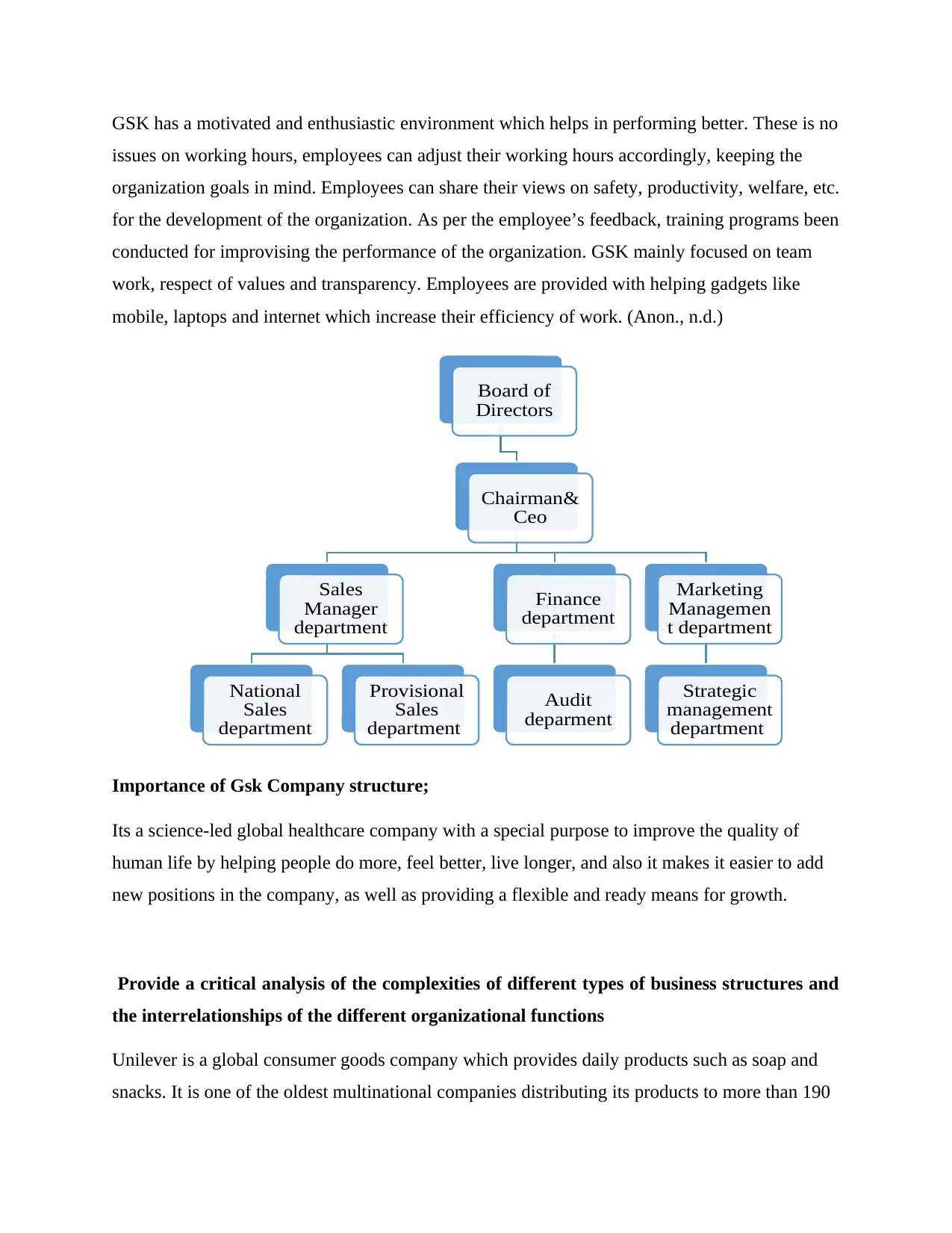
GSK has a motivated and enthusiastic environment which helps in performing better. These is no
issues on working hours, employees can adjust their working hours accordingly, keeping the
organization goals in mind. Employees can share their views on safety, productivity, welfare, etc.
for the development of the organization. As per the employee’s feedback, training programs been
conducted for improvising the performance of the organization. GSK mainly focused on team
work, respect of values and transparency. Employees are provided with helping gadgets like
mobile, laptops and internet which increase their efficiency of work. (Anon., n.d.)
Importance of Gsk Company structure;
Its a science-led global healthcare company with a special purpose to improve the quality of
human life by helping people do more, feel better, live longer, and also it makes it easier to add
new positions in the company, as well as providing a flexible and ready means for growth.
Provide a critical analysis of the complexities of different types of business structures and
the interrelationships of the different organizational functions
Unilever is a global consumer goods company which provides daily products such as soap and
snacks. It is one of the oldest multinational companies distributing its products to more than 190
Board of
Directors
Chairman&
Ceo
Sales
Manager
department
National
Sales
department
Provisional
Sales
department
Finance
department
Audit
deparment
Marketing
Managemen
t department
Strategic
management
department
issues on working hours, employees can adjust their working hours accordingly, keeping the
organization goals in mind. Employees can share their views on safety, productivity, welfare, etc.
for the development of the organization. As per the employee’s feedback, training programs been
conducted for improvising the performance of the organization. GSK mainly focused on team
work, respect of values and transparency. Employees are provided with helping gadgets like
mobile, laptops and internet which increase their efficiency of work. (Anon., n.d.)
Importance of Gsk Company structure;
Its a science-led global healthcare company with a special purpose to improve the quality of
human life by helping people do more, feel better, live longer, and also it makes it easier to add
new positions in the company, as well as providing a flexible and ready means for growth.
Provide a critical analysis of the complexities of different types of business structures and
the interrelationships of the different organizational functions
Unilever is a global consumer goods company which provides daily products such as soap and
snacks. It is one of the oldest multinational companies distributing its products to more than 190
Board of
Directors
Chairman&
Ceo
Sales
Manager
department
National
Sales
department
Provisional
Sales
department
Finance
department
Audit
deparment
Marketing
Managemen
t department
Strategic
management
department
Paraphrase This Document
Need a fresh take? Get an instant paraphrase of this document with our AI Paraphraser
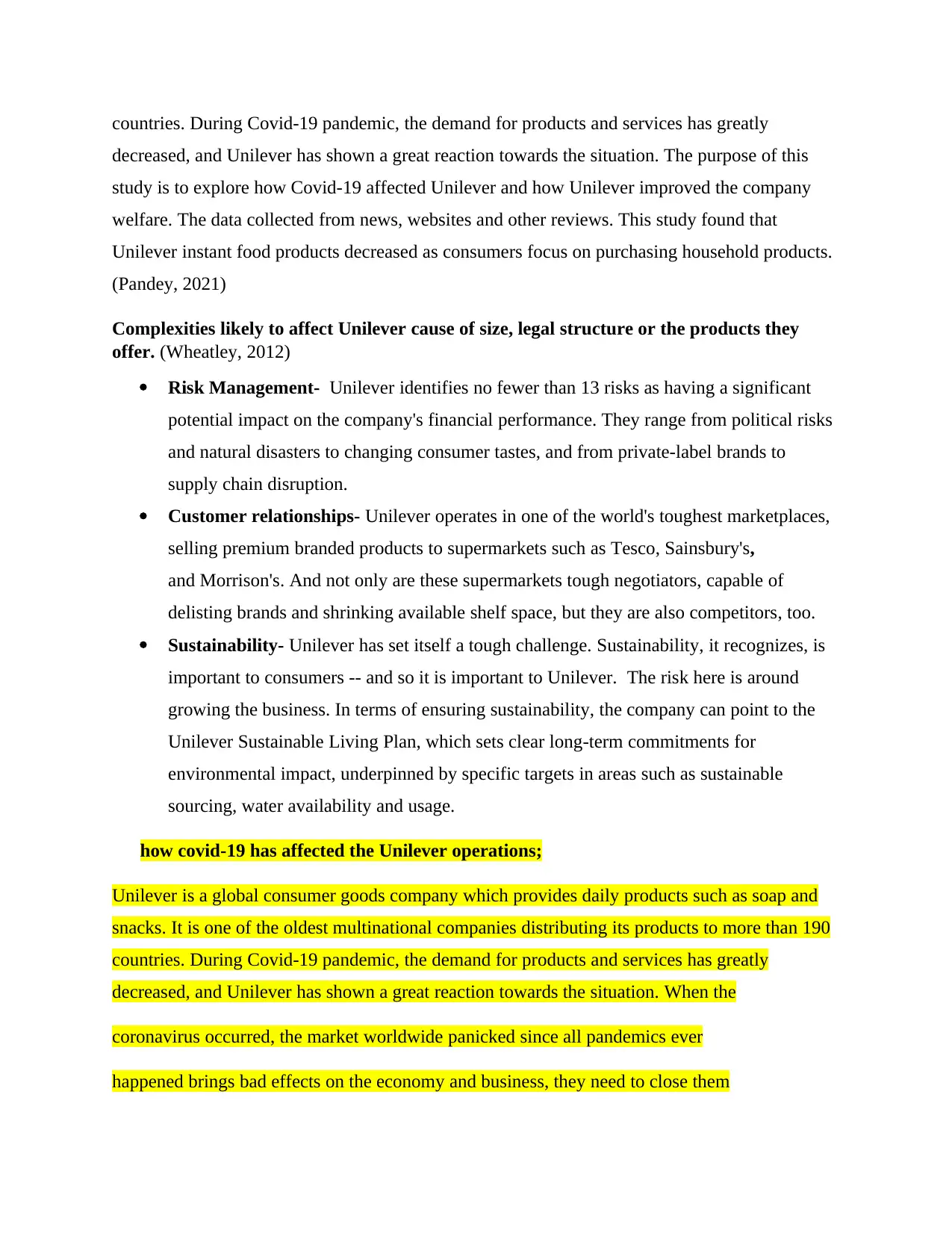
countries. During Covid-19 pandemic, the demand for products and services has greatly
decreased, and Unilever has shown a great reaction towards the situation. The purpose of this
study is to explore how Covid-19 affected Unilever and how Unilever improved the company
welfare. The data collected from news, websites and other reviews. This study found that
Unilever instant food products decreased as consumers focus on purchasing household products.
(Pandey, 2021)
Complexities likely to affect Unilever cause of size, legal structure or the products they
offer. (Wheatley, 2012)
Risk Management- Unilever identifies no fewer than 13 risks as having a significant
potential impact on the company's financial performance. They range from political risks
and natural disasters to changing consumer tastes, and from private-label brands to
supply chain disruption.
Customer relationships- Unilever operates in one of the world's toughest marketplaces,
selling premium branded products to supermarkets such as Tesco, Sainsbury's,
and Morrison's. And not only are these supermarkets tough negotiators, capable of
delisting brands and shrinking available shelf space, but they are also competitors, too.
Sustainability- Unilever has set itself a tough challenge. Sustainability, it recognizes, is
important to consumers -- and so it is important to Unilever. The risk here is around
growing the business. In terms of ensuring sustainability, the company can point to the
Unilever Sustainable Living Plan, which sets clear long-term commitments for
environmental impact, underpinned by specific targets in areas such as sustainable
sourcing, water availability and usage.
how covid-19 has affected the Unilever operations;
Unilever is a global consumer goods company which provides daily products such as soap and
snacks. It is one of the oldest multinational companies distributing its products to more than 190
countries. During Covid-19 pandemic, the demand for products and services has greatly
decreased, and Unilever has shown a great reaction towards the situation. When the
coronavirus occurred, the market worldwide panicked since all pandemics ever
happened brings bad effects on the economy and business, they need to close them
decreased, and Unilever has shown a great reaction towards the situation. The purpose of this
study is to explore how Covid-19 affected Unilever and how Unilever improved the company
welfare. The data collected from news, websites and other reviews. This study found that
Unilever instant food products decreased as consumers focus on purchasing household products.
(Pandey, 2021)
Complexities likely to affect Unilever cause of size, legal structure or the products they
offer. (Wheatley, 2012)
Risk Management- Unilever identifies no fewer than 13 risks as having a significant
potential impact on the company's financial performance. They range from political risks
and natural disasters to changing consumer tastes, and from private-label brands to
supply chain disruption.
Customer relationships- Unilever operates in one of the world's toughest marketplaces,
selling premium branded products to supermarkets such as Tesco, Sainsbury's,
and Morrison's. And not only are these supermarkets tough negotiators, capable of
delisting brands and shrinking available shelf space, but they are also competitors, too.
Sustainability- Unilever has set itself a tough challenge. Sustainability, it recognizes, is
important to consumers -- and so it is important to Unilever. The risk here is around
growing the business. In terms of ensuring sustainability, the company can point to the
Unilever Sustainable Living Plan, which sets clear long-term commitments for
environmental impact, underpinned by specific targets in areas such as sustainable
sourcing, water availability and usage.
how covid-19 has affected the Unilever operations;
Unilever is a global consumer goods company which provides daily products such as soap and
snacks. It is one of the oldest multinational companies distributing its products to more than 190
countries. During Covid-19 pandemic, the demand for products and services has greatly
decreased, and Unilever has shown a great reaction towards the situation. When the
coronavirus occurred, the market worldwide panicked since all pandemics ever
happened brings bad effects on the economy and business, they need to close them
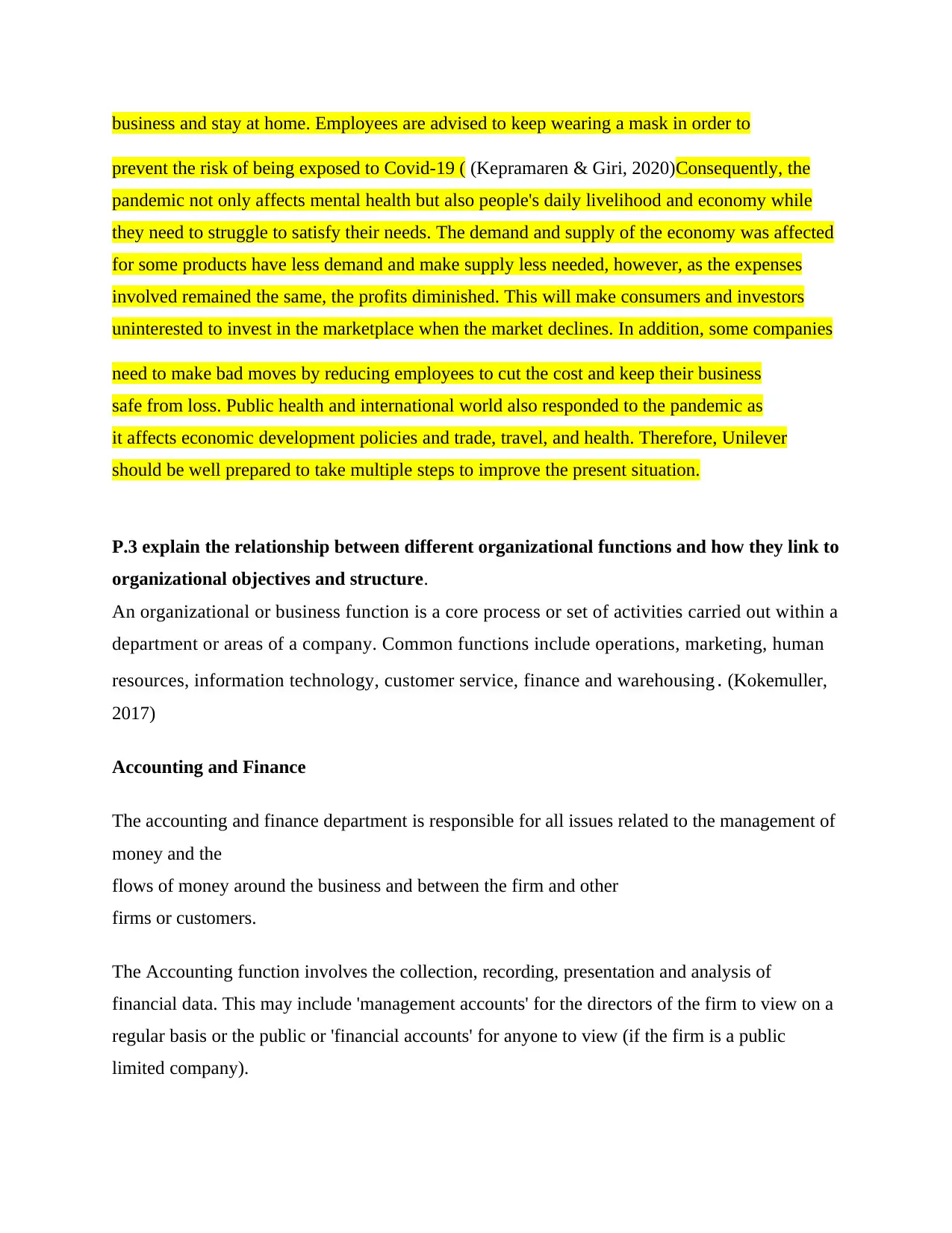
business and stay at home. Employees are advised to keep wearing a mask in order to
prevent the risk of being exposed to Covid-19 ( (Kepramaren & Giri, 2020)Consequently, the
pandemic not only affects mental health but also people's daily livelihood and economy while
they need to struggle to satisfy their needs. The demand and supply of the economy was affected
for some products have less demand and make supply less needed, however, as the expenses
involved remained the same, the profits diminished. This will make consumers and investors
uninterested to invest in the marketplace when the market declines. In addition, some companies
need to make bad moves by reducing employees to cut the cost and keep their business
safe from loss. Public health and international world also responded to the pandemic as
it affects economic development policies and trade, travel, and health. Therefore, Unilever
should be well prepared to take multiple steps to improve the present situation.
P.3 explain the relationship between different organizational functions and how they link to
organizational objectives and structure.
An organizational or business function is a core process or set of activities carried out within a
department or areas of a company. Common functions include operations, marketing, human
resources, information technology, customer service, finance and warehousing. (Kokemuller,
2017)
Accounting and Finance
The accounting and finance department is responsible for all issues related to the management of
money and the
flows of money around the business and between the firm and other
firms or customers.
The Accounting function involves the collection, recording, presentation and analysis of
financial data. This may include 'management accounts' for the directors of the firm to view on a
regular basis or the public or 'financial accounts' for anyone to view (if the firm is a public
limited company).
prevent the risk of being exposed to Covid-19 ( (Kepramaren & Giri, 2020)Consequently, the
pandemic not only affects mental health but also people's daily livelihood and economy while
they need to struggle to satisfy their needs. The demand and supply of the economy was affected
for some products have less demand and make supply less needed, however, as the expenses
involved remained the same, the profits diminished. This will make consumers and investors
uninterested to invest in the marketplace when the market declines. In addition, some companies
need to make bad moves by reducing employees to cut the cost and keep their business
safe from loss. Public health and international world also responded to the pandemic as
it affects economic development policies and trade, travel, and health. Therefore, Unilever
should be well prepared to take multiple steps to improve the present situation.
P.3 explain the relationship between different organizational functions and how they link to
organizational objectives and structure.
An organizational or business function is a core process or set of activities carried out within a
department or areas of a company. Common functions include operations, marketing, human
resources, information technology, customer service, finance and warehousing. (Kokemuller,
2017)
Accounting and Finance
The accounting and finance department is responsible for all issues related to the management of
money and the
flows of money around the business and between the firm and other
firms or customers.
The Accounting function involves the collection, recording, presentation and analysis of
financial data. This may include 'management accounts' for the directors of the firm to view on a
regular basis or the public or 'financial accounts' for anyone to view (if the firm is a public
limited company).
⊘ This is a preview!⊘
Do you want full access?
Subscribe today to unlock all pages.

Trusted by 1+ million students worldwide
1 out of 16
Related Documents
Your All-in-One AI-Powered Toolkit for Academic Success.
+13062052269
info@desklib.com
Available 24*7 on WhatsApp / Email
![[object Object]](/_next/static/media/star-bottom.7253800d.svg)
Unlock your academic potential
Copyright © 2020–2025 A2Z Services. All Rights Reserved. Developed and managed by ZUCOL.



